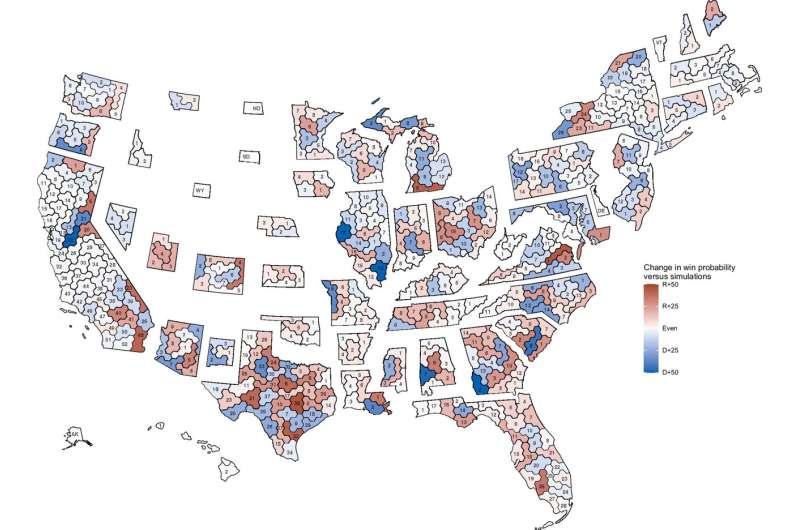June 16, 2023 report
This article has been reviewed according to Science X's editorial process and policies. Editors have highlighted the following attributes while ensuring the content's credibility:
fact-checked
peer-reviewed publication
trusted source
proofread
Simulations show politically motivated gerrymandering mostly evens out on a national scale

A group of political scientists from Harvard University, working with a colleague from Yale University, has found via simulations that politically motivated gerrymandering in the U.S. tends to cancel out as both sides change voting borders. In their study, reported in Proceedings of the National Academy of Sciences, Christopher Kenny, Cory McCartan, Tyler Simko, Kosuke Imai and Shiro Kuriwaki used simulations to compare congressional mapping in the U.S. using data from the 2020 census.
The political system in the United States is, by any account, a complicated affair. The government is made up of three main branches, the legislative, executive, and judicial. The judicial branch is made up of the U.S. Supreme Court; the executive branch is essentially the President of the United States. The Legislative branch is divided into two parts; the Senate and the Congress, all of whom are elected to their positions by people residing in the states that they represent.
Each state gets two senators, no matter its size or population. The opposite is true for people elected to Congress. Every 10 years, the U.S. conducts a national census, and the data is used to determine how many representatives come from each state. Those with more people get more representatives, while the total number of seats remains constant at 435.
Each representative is elected by people in his or her district, but the people elected to the state government get to redraw the district lines whenever they so choose. Such redistricting is almost always done with political gain in mind. A state run by conservatives, for example, may draw lines outlining different parts of a city, or outlying area, for example, to include as many liberals as possible, hoping to give them only a single congressional representative, thereby reducing the number of liberals elected to congress from their state.
On the positive side, such politically motivated redistricting, known as gerrymandering, is conducted by both of the main parties in the U.S., thus canceling out opposing efforts. In this new effort, the research team sought to find out if that is the case.
The political scientists used simulations that have been created and modified by researchers over time to demonstrate the impact of gerrymandering on elections and fair representation. They entered data and used graphic tools to draw the district lines and then added data from the 2020 census. They then redrew the district lines to match those politicians had drawn to see the impact of redistricting on representation.
The research team found that there was widespread partisan bias, as expected. But they also found that most gerrymandering was canceled out by opposite-party gerrymandering in other parts of the country. Overall, they found that clever redistricting had given the Republican party only a two-seat advantage compared to simulations including no gerrymandering by either party.
That said, they noted that because of geographical differences, gerrymandering has been more beneficial to the Republicans over many years, conferring a current eight-seat advantage overall.
More information: Christopher T. Kenny et al, Widespread partisan gerrymandering mostly cancels nationally, but reduces electoral competition, Proceedings of the National Academy of Sciences (2023). DOI: 10.1073/pnas.2217322120
Journal information: Proceedings of the National Academy of Sciences
© 2023 Science X Network





















